
The common carpet or white-banded toothed carpet is a moth of the family Geometridae. The species was first described by Otto Friedrich Müller in 1764. It is found throughout the Palearctic and the Near East. In North America it ranges across the northern tier of the United States plus every province and territory of Canada.
Forma specialis, abbreviated f. sp. without italics, is an informal taxonomic grouping allowed by the International Code of Nomenclature for algae, fungi, and plants, that is applied to a parasite which is adapted to a specific host. This classification may be applied by authors who do not feel that a subspecies or variety name is appropriate, and it is therefore not necessary to specify morphological differences that distinguish this form. The literal meaning of the term is 'special form', but this grouping does not correspond to the more formal botanical use of the taxonomic rank of forma or form.
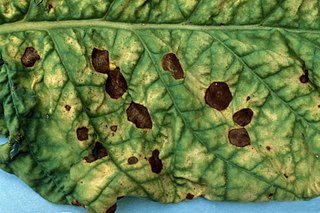
Alternaria alternata is a fungus causing leaf spots, rots, and blights on many plant parts, and other diseases. It is an opportunistic pathogen on over 380 host species of plant.

Macaria alternata, the sharp-angled peacock, is a moth of the family Geometridae. It is found in Europe, Turkey, the Caucasus, Georgia and South Siberia.

Macaria notata, the peacock moth, is a moth of the family Geometridae. It is a Holarctic species.

Anguispira alternata, common name the flamed disc or flamed tigersnail, is a species of air-breathing land snail, a terrestrial pulmonate gastropod mollusk in the family Discidae, the disk snails. Flamed discs are medium-sized snails, with shells ranging from 17 to 25 millimeters in diameter. They are found around logs, hollow trees, and rocks in wooded areas throughout eastern North America, ranging from New Brunswick, Canada, south to northern Florida, and west to northeastern Texas, Kansas and western Minnesota. Flamed disks are herbivores that feed on decaying plant material, fungi, and algae.

Abagrotis alternata, the greater red dart or mottled gray cutworm, is a moth of the family Noctuidae. The species was first described by Augustus Radcliffe Grote in 1865. It is found in eastern North America, from New Brunswick west across southern Canada to western Alberta, south to Arizona, New Mexico and the Gulf of Mexico.

Amblyscirtes alternata is a butterfly of the family Hesperiidae. It is found from south-eastern Virginia south to Florida, west to east Texas.
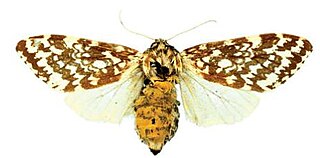
Lophocampa alternata is a moth of the family Erebidae. It was described by Augustus Radcliffe Grote in 1867. It is known from Cuba.

Temognatha alternata is endemic to Queensland, Australia. Little is known of this spectacular beetle which has never been formally described, as the name is taken from that given by Lumholtz without any description.

Eunidiini is a tribe of longhorn beetles of the subfamily Lamiinae. It was described by Téocchi et al. in 2010.
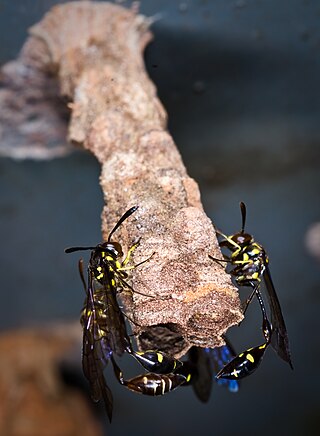
Parischnogaster alternata, the black hover wasp, is a eusocial wasp in the genus Parischnogaster. It is native to South-East Asia, and builds its nests in cavities located in dark and damp locations. The nests of black hover wasps are often found in clusters, which serves as a passive defense mechanism against predators. The annual colony cycle begins with nest initiation by a single foundress though colonies typically consist of 2-3 associative females and helpers that aid in brood development, nest construction, and colony defense. Indicative of the name, female P. alternata are known to strategically hover near nests when visiting other colonies before landing. These intrusions produce responses ranging from aerial fighting to cooperative food sharing.

Eunidia is a genus of longhorn beetles of the subfamily Lamiinae.

Eunidia tripunctata is a species of beetle in the family Cerambycidae. It was described by Per Olof Christopher Aurivillius in 1911.
Eunidia batesi is a species of beetle in the family Cerambycidae. It was described by Olliff in 1889.
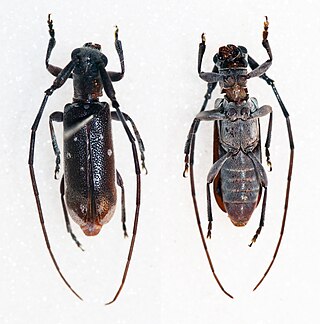
Eunidia thomseni is a species of beetle in the family Cerambycidae. It was described by William Lucas Distant in 1898. It is known from Tanzania, Cameroon, Chad, Niger, Ethiopia, Senegal, Mozambique, Botswana, Namibia, Saudi Arabia, the Central African Republic, Somalia, Uganda, South Africa, Yemen, Kenya, and Zimbabwe.
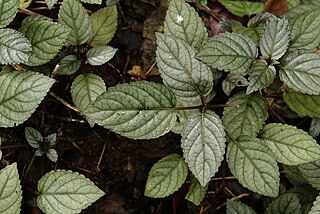
Strobilanthes alternata, may be known as red ivy, red-flame ivy, or waffle plant, is a member of the family Acanthaceae native to Java. It is a prostrate plant with purple colored leaves.
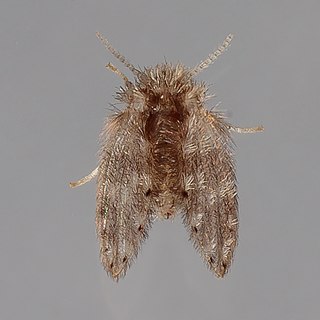
Psychoda alternata is a species of moth fly in the family Psychodidae, commonly known as the trickling filter fly or drain fly. The larva is semiaquatic and lives in the gelatinous ooze associated with leaks of sewage effluent, drains, and in trickling filter systems.

Rafinesquina is an extinct genus of large brachiopod that existed from the Darriwilian to the Ludlow epoch.

Hysteroconcha is a genus of saltwater clams, marine bivalve molluscs in the subfamily Callocardiinae of the family Veneridae, the Venus clams.
















